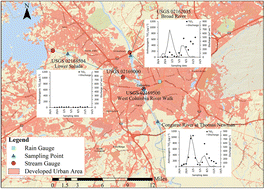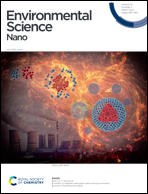Urban runoff drives titanium dioxide engineered particle concentrations in urban watersheds: field measurements†
Abstract
Urban runoff is a significant source of pollutants, including incidental and engineered nanoparticles, to receiving surface waters. The aim of this study is to investigate the impact of urbanization on the concentrations of TiO2 engineered particles in urban surface waters. The study area boundaries are limited to the Lower Saluda and Nicholas Creek-Broad River from upstream, and outlet of upper Congaree River in Columbia, South Carolina, United States from downstream. This sampling area captures a significant footprint of the urban area of the city of Columbia. Water samples were collected daily from four sites during two rain events. All samples were analyzed for total metal concentrations following acid digestion and for particle number concentration and elemental composition using single particle-inductively coupled plasma-time of flight-mass spectrometry (SP-ICP-TOF-MS). The Ti/Nb ratios in the Broad and Congaree River samples are generally higher than those of natural background ratios, indicating contamination of these two rivers with anthropogenic Ti-bearing particles. Clustering of multi-metal nanoparticles (mmNPs) demonstrated that Ti-bearing particles are distributed mainly among three clusters, FeTiMn, AlSiFe, and TiMnFe, which are typical of naturally occurring iron oxide, clay, and titanium oxide particles, indicating the absence of significant number of anthropogenic multi-element Ti-bearing particles. Thus, anthropogenic Ti-bearing particles are attributed to single-metal particles; that is pure TiO2 particles. The total concentration of anthropogenic TiO2 in the rivers was determined by mass balance calculation using bulk titanium concentration and increases in Ti/Nb above the natural background ratio. The concentration of anthropogenic TiO2 increases following the order 0 to 24 μg L−1 in the Lower Saluda River <0 to 663 μg L−1 in the Broad River <43 to 1051 μg L−1 in Congaree River at Cayce <58 to 5050 μg L−1 in the Congaree River at Columbia. The concentration of anthropogenic TiO2 increases with increases in urban runoff. The source of anthropogenic TiO2 is attributed to diffuse urban runoff. This study demonstrates that diffuse urban runoff results in high concentrations of TiO2 particles in urban surface waters during and following rainfall events which may pose increased risks to aquatic organisms during these episodic events.

- This article is part of the themed collection: Environmental Science: Nano Recent HOT Articles


 Please wait while we load your content...
Please wait while we load your content...